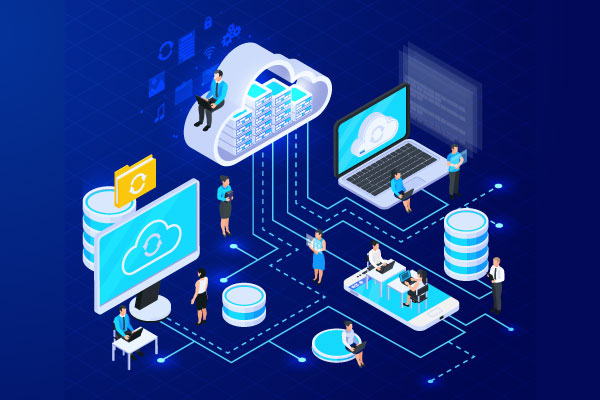Top 6 Competitive Advantages of Cloud Edge Computing
by Sachin Rane, on May 27, 2022 8:53:46 PM
Estimated reading time: 4 mins
Key takeaways from this blog
- Cloud Edge Computing and 5G have enormous potential to give a fillip to the business landscape.
- It allows businesses to overcome inhibitions due to data residency and data transmission latency issues.
- It imparts high responsiveness to the ecosystem by cutting down data transmission time.

Quite a few sectors are late in Cloud adoption due to data residency and data transmission latency issues. They kept the Cloud adoption and migration in abeyance because of the sensitive nature of the data they work with. However, Cloud technology is maturing at a hyper pace. Cloud Edge Computing, which is an advanced version of Hybrid Cloud, addresses these very issues of handling sensitive data and offers a competitive advantage. With the evolution of the 5G spectrum and 6G on the anvil, Cloud Edge Computing is set to bring a dramatic change in the business landscape. Similarly, this technology combination builds up a latent potential to address use cases that were simply unimaginable in the recent past. With the power of Cloud Edge Computing and 5G, manufacturing, retail, and banking financial services can fast track their digital enablement and revolutionize their process architecture.
What is Cloud Edge Computing?
Cloud Edge Computing is the data computing closer to the point where the data is created or the edge. In manufacturing, the edge is the assembly line. In banking, the edge could be the local data processing hub. In the case of ATMs, the edge is the ATM machine or the ATM machine room. In retail, the edge could be the SKU rack for that particular product. In healthcare and diagnostics, the data center that stores the reports and scans is the edge. In the automobile industry, a wifi-enabled electric vehicle could be the edge.
When data residency, as well as data transmission, issues are critical, Cloud Edge Computing is the answer –
- If we consider the manufacturing assembly line, a high-definition camera along with analytical processing algorithms functions as the eagle eye for validating the product quality at the edge.
- In the case of banks, where highly sensitive data is handled, the local data processing hub accompanied with Cloud computing rack at the edge lends a high processing and computing power for data analysis.
- In case of ATM machines, suspicious activity can be identified on high definition cameras with AI-enabled algorithms and conveyed in real-time to the local security agency for quick action.
- In retail outlets, AI-enabled sensors trace the activity off the SKU racks so that the inventory can be immediately replenished while tracking the demand for the product in real-time. Another AI-enabled beacon system, which is tagged to the retail CRM that has the consumer details along with mobile phone number, can track the consumer in the vicinity and send flash sale messages in proportion with the consumer’s lifetime value.
- In healthcare and diagnostics, where the data is highly confidential, the processing is done at the local satellite/branch and then integrated with the centralized systems.
- In the automobile industry, AI-enabled computing that accompanies sensors identifies unscrupulous activity in the vicinity and alerts the user and local security agency in the vicinity.
Why are organizations adopting Cloud Edge Computing?
Cloud Edge Computing imparts high responsiveness to the process architecture that otherwise breeds latency. It brings hard decisions under the purview of automation through the use of AI/ML algorithms at the point of data creation without wasting time in relaying data to centralized processing hubs. Cloud Edge Computing along with 5G opens the gateways for innovation at scale. Along with the use of complementary technologies, Cloud Edge Computing extends the scope of automation and raises the bar.
Cloud Edge Computing – Complementary technologies
While Cloud Edge accelerates the computing at the point of data generation and cuts down the time in data transmission at a central point for processing, a number of technologies complement its use.- RFID/Sensors/IoT: These technologies singularly and severally generate a high amount of data in different scenarios, such as shop floor, retail outlets, inventory stock hubs, machinery usage monitoring, and manufacturing assembly line monitoring. Along with Cloud Computing at the Edge and AI/ML algorithms hard decision automation becomes feasible without human involvement or centralized hub monitoring.
- Predictive Analytics: This technology along with Cloud Computing at the Edge plays an important role in predictive maintenance.
- Data Visualization: It empowers the management to visualize the data generated at the Edge.
- RPA: It transfers and integrates the data with the Central Hub as soon as the 5G connectivity is available.
Cloud Edge Computing – Top 6 competitive advantages
- Machine power optimization: Imparts intelligence and scales up the use of the asset in the ecosystem.
- Insight generation at the Edge: Generates actionable insights at the edge while automating complex and challenging decisions.
- Real-time predictive analytics: Generates real-time insights that are otherwise overlooked thus improving and optimizing the asset utilization through predictive maintenance.
- Responsive action in real-time: Improves process responsiveness of the overall ecosystem for real-time action.
- High agility and availability: Improves the speed and overall availability and allows to stay ahead of the competition.
- Proactive processing of complex triggers: Automates the complex decision-making process and speeds it up to split-seconds at the Edge.
Simply put
Cloud Edge Computing allows late Cloud adopters to overcome inhibitions resulting due to data residency and data transmission issues. Along with 5G, Cloud Edge Computing enables businesses to envisage new use cases that were unimaginable in the recent past. It imparts high responsiveness to the ecosystem by cutting down transmission time and generation of real-time insights that can be later integrated with the central systems by using RPA.

















